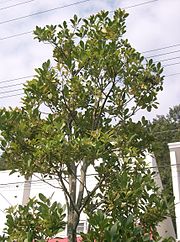Ilex integra
| Ilex integra subsp. var. | Mochi Tree, Nepal Holly | |||||||||||||||||||||||||||||||||||||||||||||||||||||||
|---|---|---|---|---|---|---|---|---|---|---|---|---|---|---|---|---|---|---|---|---|---|---|---|---|---|---|---|---|---|---|---|---|---|---|---|---|---|---|---|---|---|---|---|---|---|---|---|---|---|---|---|---|---|---|---|---|

|
|
| ||||||||||||||||||||||||||||||||||||||||||||||||||||||
| ||||||||||||||||||||||||||||||||||||||||||||||||||||||||
Ilex integra, or Mochitree, is an ornamental tree of the holly genus, which is native to parts of Asia, including Korea; Taiwan; the mid-southern regions of China; and Honshu, Shikoku and Kyushu in Japan. Its flower is light-yellow.[1][2] The species was botanically described in 1784.[3]
| Standard Cyclopedia of Horticulture |
|---|
|
Ilex integra, Thunb. (Othera japonica, Thunb. Ilex othera, Spreng.). Evergreen shrub or tree, to 40 ft., glabrous: lvs. slender-petioled. oval to elliptic-oblong or oblong-obovate, rarely oblanceolate, narrowed at the base, at the apex contracted into a short obtuse point, entire, very rarely with a few teeth, indistinctly veined, 2-3 ½ in. long; petiole 1/3 - ¾ in. long: fls. on stalks 1/5 – 1/3 in. long, in axillary fascicles on branches of the previous year: fr. red, globose or ovoid, 1/3 – ½ in. long. Feb.-April; fr. in Aug.-Oct. Japan.—Variable in the size and shape of the Ivs. and in the length of the pedicels; one of the forms is cult, in the S. as Othera japonica.
|
Cultivation
Propagation
Pests and diseases
Varieties
Gallery
References
- Standard Cyclopedia of Horticulture, by L. H. Bailey, MacMillan Co., 1963
External links
- w:Ilex integra. Some of the material on this page may be from Wikipedia, under the Creative Commons license.
- Ilex integra QR Code (Size 50, 100, 200, 500)
Cite error:
<ref> tags exist, but no <references/> tag was found

